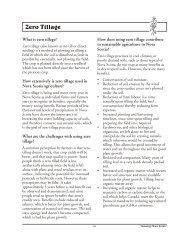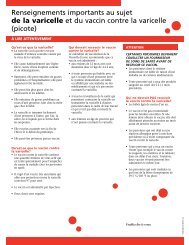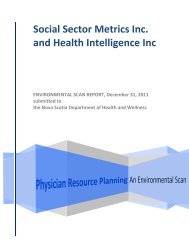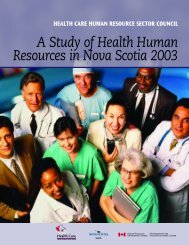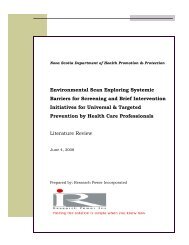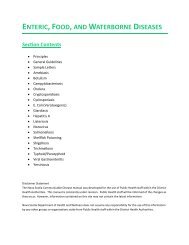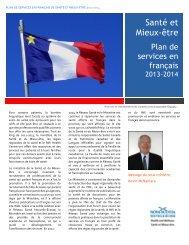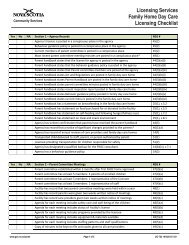Nova Scotia's Renewed Injury Prevention Strategy - Government of ...
Nova Scotia's Renewed Injury Prevention Strategy - Government of ...
Nova Scotia's Renewed Injury Prevention Strategy - Government of ...
- No tags were found...
Create successful ePaper yourself
Turn your PDF publications into a flip-book with our unique Google optimized e-Paper software.
Key ConceptsThe involvement <strong>of</strong> so many sectors andorganizations in injury prevention can lead toconfusion around language, roles, and approaches.The intent <strong>of</strong> this section is to highlight somecommon approaches—those that are grounded inevidence and best practices, and that are integral toour work. This section explains six key interrelatedconcepts that are used nationally and internationallyto promote health and lead to a reduction in illnessand injuries. These six key concepts must be appliedin our injury prevention work in <strong>Nova</strong> Scotia.Population health builds on the five strategiesoutlined in the Ottawa Charter for HealthPromotion 30 to impact the social determinants <strong>of</strong>health, reduce health disparities, and improve theoverall health <strong>of</strong> the population.Health PromotionPopulation health approaches in Canada andinternationally draw heavily from the field <strong>of</strong> healthpromotion, particularly the Ottawa Charter forHealth Promotion. The Charter advances fiveessential strategies for promoting health andpreventing injury and illness:Taking It to the Next Level <strong>Nova</strong> Scotia’s <strong>Renewed</strong> <strong>Injury</strong> <strong>Prevention</strong> <strong>Strategy</strong>Population Health“Population health builds on a long tradition <strong>of</strong>public health and health promotion.” 29 Drawing onthe strategies <strong>of</strong> health promotion (explainedbelow), population health is a widely usedframework for understanding patterns <strong>of</strong> health,illness, and injury on a population-wide scale. Apopulation health perspective on injury preventionleads to questions such as: What kinds <strong>of</strong> injuriesare occurring? Are certain population groups morelikely to be injured? Are there conditions in thesocial and physical environment that lead to thelikelihood <strong>of</strong> injury? Taking a population healthapproach to injury prevention means• focusing on the entire population as well as subgroupswithin the population• using health promotion strategies to engage inactions at multiple levels and in multiple settings• addressing the social determinants <strong>of</strong> health andtheir interactions• paying particular attention to populations wherethe greatest health disparities exist• collaborating across the boundaries <strong>of</strong> varioussectors• engaging with communities• making evidence-informed decisions and beingaccountable for the results• Building healthy public policy—Putting health onthe agenda <strong>of</strong> policy makers in all sectors and atall levels.• Creating supportive environments—Recognizingthe influences <strong>of</strong> social and physical environmentsand the need for healthy and safe choices to beavailable for everyone.• Strengthening community action—Empoweringcommunities to take control and ownership <strong>of</strong>their own endeavors and destinies.• Developing personal skills—Increasing the ability<strong>of</strong> people to exercise more control over their owndestinies and the environments that influencetheir health.• Reorienting health and other services—Responding to the need to focus on preventionrather than treatment. While the focus hastypically been on reorienting health services, othersectors such as the justice system can also play apowerful role in meaningfully impacting the rootcauses <strong>of</strong> injury and poor health.34



